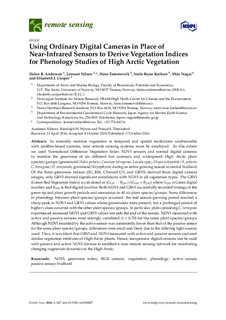Using ordinary digital cameras in place of near-infrared sensors to derive vegetation indices for phenology studies of high arctic vegetation
Anderson, Helen; Nilsen, Lennart; Tømmervik, Hans; Karlsen, Stein Rune; Nagai, Shin; Cooper, Elisabeth J.
Journal article, Peer reviewed
Permanent lenke
http://hdl.handle.net/11250/2422469Utgivelsesdato
2016Metadata
Vis full innførselSamlinger
- Publikasjoner fra CRIStin - NINA [2364]
- Scientific publications [1392]
Sammendrag
To remotely monitor vegetation at temporal and spatial resolutions unobtainable
with satellite-based systems, near remote sensing systems must be employed. To this extent
we used Normalized Difference Vegetation Index NDVI sensors and normal digital cameras
to monitor the greenness of six different but common and widespread High Arctic plant
species/groups (graminoid/Salix polaris; Cassiope tetragona; Luzula spp.; Dryas octopetala/S. polaris;
C. tetragona/D. octopetala; graminoid/bryophyte) during an entire growing season in central Svalbard.
Of the three greenness indices (2G_RBi, Channel G% and GRVI) derived from digital camera images,
only GRVI showed significant correlations with NDVI in all vegetation types. The GRVI (Green-Red
Vegetation Index) is calculated as (GDN ��������� RDN)/(GDN + RDN) where GDN is Green digital number and
RDN is Red digital number. Both NDVI and GRVI successfully recorded timings of the green-up and
plant growth periods and senescence in all six plant species/groups. Some differences in phenology
between plant species/groups occurred: the mid-season growing period reached a sharp peak in
NDVI and GRVI values where graminoids were present, but a prolonged period of higher values
occurred with the other plant species/groups. Unlike the other plant species/groups, C. tetragona
experienced increased NDVI and GRVI values towards the end of the season. NDVI measured with
active and passive sensors were strongly correlated (r2 > 0.70) for the same plant species/groups.
Although NDVI recorded by the active sensor was consistently lower than that of the passive sensor
for the same plant species/groups, differences were small and likely due to the differing light sources
used. Thus, it is evident that GRVI and NDVI measured with active and passive sensors captured
similar vegetation attributes of High Arctic plants. Hence, inexpensive digital cameras can be used
with passive and active NDVI devices to establish a near remote sensing network for monitoring
changing vegetation dynamics in the High Arctic.
NDVI; greenness index; RGB camera; vegetation; phenology; active sensor;
passive sensor; Svalbard

